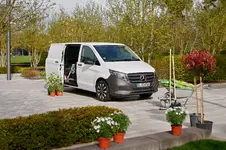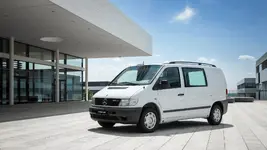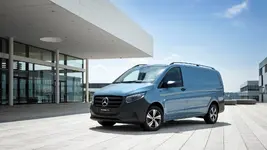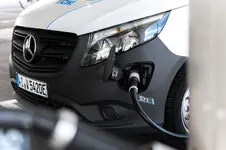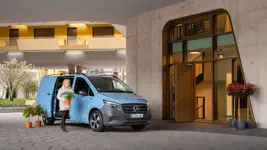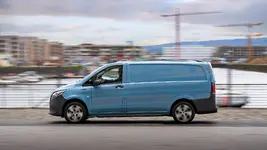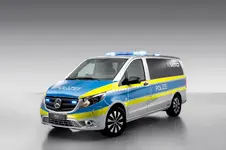- Working hard since 1995 for tradespeople, services, first responders and more: The Vito has a long-standing reputation as a compact, reliable and flexible van suitable for a wide range of everyday tasks
- E-mobility pioneer: Electric versions of the Vito have been setting standards for local CO₂‑emission‑free operation in the midsize segment since 2010
- Strong support in the portfolio: Commercial midsize vans Vito and eVito account for nearly a quarter of Mercedes‑Benz Vans' sales
- Namesake: The Vitoria plant has been inseparably linked to the Mercedes‑Benz Vito for 30 years
- The latest model generation: new levels of connectivity and comfort
Thanks to modern safety and assistance systems, digital networking and the many available versions, it supports customers in their daily work. With the eVito, Mercedes‑Benz Vans has also offered an alternative for local CO₂-emission-free driving since 2018. Its predecessor, the Vito E-CELL, was embraced by many customers starting back in 2010. Vito and eVito show their strengths above all in urban environments, where their compact size not only allows them to fit into modern public parking garages, it also helps to keep urban life running in narrow streets. Nearly a quarter of Mercedes‑Benz Vans customers therefore opt for commercial midsize vans.
“Over the last 30 years, the Vito has proven to be a true all-rounder for professionals. Thanks to its compact dimensions and large cargo space, it is an ideal choice for urban settings. For our customers, the Vito offers a high level of functionality and flexibility, combined with comfort and efficiency. Like our Sprinter, it has kept the world mobile for 30 years. In its electric version, the eVito stands for sustainable, locally CO₂-emission-free mobility for nearly eight years.”
Sagree Sardien, Head of Sales & Marketing Mercedes‑Benz Vans
Mercedes-Benz Vito: the history
The Mercedes-Benz Vito has offered a convincing solution geared to the needs of tradespeople, retailers and service providers since 1995. It is the versatile allrounder among the commercially positioned midsize vans. Key milestones:
- 1995: the first generation with transversely mounted four-cylinder diesel and petrol engines
The first generation also offered an extensive safety package as standard that was impressive for its time. This included driver airbag, independent wheel suspension and disk brakes on all wheels, ABS with automatic braking differential and power steering.
The transversely mounted four-cylinder diesel and petrol engines boasted low fuel consumption, enabling attractive driving performance. Customers embraced the efficiency, robustness and flexibility of the Vito – which earned it the title “Van of the Year” in 1996. An update in 1999 brought a design facelift, new colours and optimised features. By 2003 Mercedes‑Benz had sold around 473,000 first-generation vehicles.
- 2003: second generation with more comfort and greater variety
The more powerful engines now available ranged from efficient four-cylinder engines to powerful V6 units. With three body lengths, two roof heights, five engine choices and numerous optional equipment packages, the second generation put the Vito firmly on the path toward the diverse range of versions available today. In 2005 the European jury again voted the Mercedes‑Benz Vito “Van of the Year”. By 2014 the second-generation Vito surpassed its outstanding predecessor with sales of nearly 750,000 units worldwide.
In addition, the second generation marked a milestone with regard to electrification: With the launch of the Vito E‑CELL in 2010, Mercedes‑Benz began small-series production of a battery-driven van equipped with a 70-kW (95-hp) electric motor. It had a range of around 130 km and was a success in such areas as courier, express and parcel services.
- 2014: third generation brings new design and even more space
This was followed in 2018 with the launch of the eVito, the first fully electric midsize van produced in series by Mercedes‑Benz. The third generation also set new standards for safety: The Vito panel van was the only vehicle in its class to be equipped with airbags and seatbelt reminders for both the driver and passengers as standard. The Vito Tourer offered up to eight airbags for all occupants. Unique among midsize vans at the time was the Crosswind Assistant included as a basic feature.
The all-electric eVito has been on the market since 2018. Whether as a panel van for delivery traffic or as a Tourer for commercial passenger transport – the eVito carried on the legacy of the E-CELL while steadily introducing technological advances.
In 2020 a new update brought many technical advances: The new OM 654 family of four-cylinder diesel engines delivered increased power combined with lower fuel consumption. In addition, the new generation featured the 9G-TRONIC automatic transmission, an optional digital inside rear-view mirror, the DISTRONIC automatic distance assist, other improved assistance systems and new comfort systems such as the AIRMATIC air suspension.
- 2024: The current Vito brings new levels of connectivity and comfort
The exterior was updated with multibeam LED headlights and the interior was enhanced with such features as a new central console and the electric EASY-PACK tailgate. The standard features were extensively upgraded and the range logic was more closely adapted to customer wishes. For the first time the drive options were expanded to include a petrol engine with mild hybrid technology.
The current models are available at prices starting at EUR 32.284,52 incl. VAT<sup>[1]</sup> (27.129,85 Euro excl. VAT).
The current eVito wins over customers with locally CO₂ emission-free drive technology, full connectivity and a range of up to 480 km (WLTP) <sup>[3]</sup>,<sup>[4]</sup> that makes it viable for everyday operations. Prices for the eVito start at EUR 43,055.51 incl. VAT<sup>[5]</sup> (36.181,10 Euro excl. VAT).
Vito – made in Vitoria for 30 years
The Vito has been produced from the outset in the historically important van factory in the Basque capital of Vitoria-Gasteiz – to which the allrounder owes its name. As the second-largest producer of Mercedes‑Benz Vans, it is one of the most important Mercedes‑Benz Vans factories worldwide. Along with the Vito and eVito, the plant also makes the V-Class models aimed at the private market as well as the EQV.
Vitoria has stood for meticulous craftsmanship, modern production technologies and strong regional ties for more than 70 years. On a premises with a total area of 696,000 m², production buildings now span an area of 373,000 m². The number of employees stands at 4,800. In March 2024 the cornerstone was laid for an expansion of the plant: Starting in 2026, vans based on the fully electric VAN Electric Architecture (VAN.EA) will be produced here. The ongoing investments in infrastructure, digitisation and training make the plant a future-ready pillar in the Mercedes-Benz Vans global production network.
[1] To use the digital extras, you are required to set up a Mercedes me ID and accept the current version of the Mercedes me ID user terms and conditions. In addition, the vehicle must be paired with the corresponding user account. Upon expiry of the limited term, the Digital Extras can be renewed on payment of a fee, provided they are still offered for the corresponding vehicle at that point.
[2] Vehicle price for individual customers in Germany incl. 19% VAT. / Price as at 09.07.2025 (Vito BASE Special Edition)
[3] The stated values were determined in accordance with the prescribed WLTP (Worldwide harmonised Light vehicles Test Procedure) measurement procedure. The indicated ranges apply to the German market. The energy consumption and CO₂ emissions of a car depend not only on the car’s efficient use of the fuel or energy source, but also on driving style and other non-technical factors. The highest value applies to the eVito panel van with battery capacity of 90 kWh and motor power of 85 kW (peak).
[4] The actual range depends on numerous factors such as the individual driving style, ambient conditions, the aging process of the battery, auxiliary consumers, such as climate control, special equipment, tires, payload, the route profile and can therefore deviate from the specified WLTP value.
[5] Vehicle price for individual customers in Germany incl. 19% VAT. / Price as at 09.07.2025
Continue reading...
